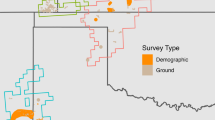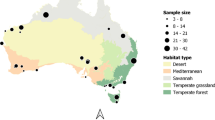Abstract
Reproductive rate is a key demographic parameter of life history and population ecology. In traditional population-ecology studies of small mammals, this and other vital rates are inferred from capture-mark-recapture (CMR) data. However, CMR assumes that immigrants at first capture can be distinguished from unmarked locally born offspring, an assumption not always met. We verified CMR estimates of locally born red squirrel (Sciurus vulgaris) offspring as a measure of reproductive rate, with candidate offspring (CO)–candidate parent (mothers, CPs) assignment by CERVUS, using ten DNA microsatellite loci. Seventy-two of 122 candidate offspring (59%) were assigned to 52 of 125 CPs in six populations. Estimates of mean litter size were 1.5 young (range 1–3). The 50 CO (41%) not assigned to a reproducing female in the study site were considered immigrants. Parentage assignment also provided evidence of dispersal between two of our sites. Overall, CMR and CERVUS agreed in 77% of cases. Considering only the 55 juveniles determined as locally born by CMR, 50 (91%) were also assigned as local offspring with CERVUS. The main discrepancy between the two methods was that 22 subadult squirrels classified immigrants by CMR, were assigned by CERVUS to females which had reproduced in our sites. It is concluded that although in our study system agreement between CMR and CERVUS in determining local offspring was high, using genetic parentage assignment helped to correctly classify some subadults, considered immigrants by CMR, as locally born. Hence, in large-scale demographic studies, combining CMR with parentage assignment will allow more precise estimates of reproduction and dispersal.
Similar content being viewed by others
References
Aars J, Dallas JF, Piertney SB, Marshall F, Gow JL, Telfer S, Lambin X (2006) Widespread gene flow and high genetic variability in populations of water voles Arvicola terrestris in patchy habitats. Mol Ecol 15:1455–1466
Andreassen HP, Ims RA (2001) Dispersal in patchy vole populations: role of patch configuration, density dependence, and demography. Ecology 82:2911–2926
Berteaux D, Boutin S (2000) Breeding dispersal in female North American red squirrels. Ecology 81:1311–1326
Boutin S, Wauters LA, McAdam AG, Humphries MM, Tosi G, Dhondt AA (2006) Anticipatory reproduction and population growth in seed predators. Science 314:1928–1930
Byrom AE, Krebs CJ (1999) Natal dispersal of juvenile arctic ground squirrels in the boreal forest. Can J Zool 77:1058–1059
Byrom AE, Karels TJ, Krebs CJ, Boonstra R (2000) Experimental manipulation of predation and food supply of arctic ground squirrels in the boreal forest. Can J Zool 78:1309–1319
Di Pierro E, Molinari A, Tosi G, Wauters LA (2008) Exclusive core areas and intrasexual territoriality in Eurasian red squirrels (Sciurus vulgaris) revealed by incremental cluster polygon analysis. Ecol Res 23:529–542
Diffendorfer JE, Gaines ME, Holt RD (1995) Habitat fragmentation and movements of three small mammals (Sigmodon, Microtus and Peromyscus). Ecology 76:827–839
Dooley JR Jr, Bowers MA (1998) Demographic responses to habitat fragmentation: experimental tests at the landscape and patch scale. Ecology 79:969–980
Dugdale HL, MacDonald DW, Pope LC, Burke T (2007) Polygynandry, extra-group paternity and multiple paternity in litters in European badger (Meles meles) social groups. Mol Ecol 16:5294–5306
Greenwood PJ (1980) Mating systems, philopatry, and dispersal in birds and mammals. Anim Behav 28:1140–1162
Hadfield JD, Richardson DS, Burke T (2006) Towards unbiased parentage assignment: combining genetic. behavioural and spatial data in a Bayesian framework. Mol Ecol 15:3715–3730
Hale ML, Bevan R, Wolff K (2001) New polymorphic microsatellite markers for the red squirrel (Sciurus vulgaris) and their applicability to the grey squirrel (S carolinensis). Mol Ecol Notes 1:47–49
Haughland DL, Larsen KW (2004) Ecology of North American red squirrels across contrasting habitats: relating natal dispersal to habitat. J Mammal 85:225–236
Jones AG, Ardren WR (2003) Methods of parentage analysis in natural populations. Mol Ecol 12:2511–2523. doi:101046/j1365-294X200301928x
Julliard R, Leirs H, Stenseth NC, Yoccoz NG, Prévot-Julliard AC, Verhagen R, Verheyen W (1999) Survival-variation within and between functional categories of the African multimammate rat. J Anim Ecol 68:550–561
Kalinowski ST, Taper ML, Marshall TC (2007) Revising how the computer program CERVUS accommodates genotyping error increases success in paternity assignment. Mol Ecol 16:1006–1099
Koch M, Hadfield JD, Sefc KM, Sturmnauer C (2008) Pedigree reconstruction in wild cichlid fish populations. Mol Ecol 17:4500–4511
Lane JE, Boutin S, Gunn MR, Slate J, Coltman DW (2008) Female multiple mating and paternity in free-ranging North American red squirrels. Anim Behav 75:1927–1937
Larsen KW, Boutin S (1994) Movements, survival, and settlement of red squirrel (Tamiasciurus hudsonicus) offspring. Ecology 75:214–223
Lemos A, Freitas AI, Fernandes AT, Goncalves R, Jesus J, Andrade C, Brehm A (2006) Microsatellite variability in natural populations of the blackspot seabream Pagellus bogaraveo (Brunnick, 1768): a database to access parentage assignment in aquaculture. Aquacult Res 37:1028–1033
Lens L, Van Dongen S, Norris K, Githiru M, Matthysen E (2002) Avian persistence in fragmented rainforest. Science 298:1236–1238
Lurz PWW, Garson PJ, Wauters LA (1997) Effects of temporal and spatial variation in habitat quality on red squirrel dispersal behaviour. Anim Behav 54:427–435
Mari V, Martini S, Romeo C, Molinari A, Martinoli A, Tosi G, Wauters LA (2008) Record litter size in the Eurasian red squirrel (Sciurus vulgaris). Hystrix It J Mamm (ns) 19:61–65
Marshall TC, Slate J, Kruuk LEB, Pemberton JM (1998) Statistical confidence for likelihood-based paternity inference in natural conditions. Mol Ecol 7:639–655
Matthysen E, Adriaensen F, Dhondt AA (1995) Dispersal distances of nuthatches Sitta europaea in a highly fragmented landscape. Oikos 72:375–381
Millar JS, McAdam AG (2001) Life on the edge: the demography of short-season populations of deer mice. Oikos 93:69–76
Oddou-Muratorio S, Houot ML, Demesure-Musch B, Austerlitz F (2003) Pollen flow in the wildservice tree, Sorbus torminalis (L) Crantz I. Evaluating the paternity analysis procedure in continuous populations. Mol Ecol 12:3427–3439
Selonen V, Hanski IK, Desrochers A (2007) Natal habitat-biased dispersal in the Siberian flying squirrel. Proc R Soc Lond B Biol Sci 274:2063–2068
Shurtliff QR, Pearse DE, Rogers DS (2005) Parentage analysis of the canyon mouse (Peromyscus crinitus): evidence for multiple paternity. J Mammal 86:531–540
Slate J, Marshall TC, Pemberton JM (2000) A retrospective assessment of the accuracy of the paternity inference program CERVUS. Mol Ecol 9:801–808
Stenseth NC, Lidicker WZ Jr (1992) Animal dispersal: small mammals as a model. Chapman and Hall, London
Telfer S, Piertney SB, Dallas JF, Stewart WA, Marshall F, Gow JL, Lambin X (2003) Parental assignment detects frequent and large-scale dispersal in water voles. Mol Ecol 12:1939–1949
Todd R (2000) Microsatellite loci in the Eurasian red squirrel, Sciurus vulgaris L. Mol Ecol 9:2165
Trizio I, Crestanello B, Galbusera P, Wauters LA, Tosi G, Matthysen E, Hauffe HC (2005) Geographical distance and physical barriers shape the genetic structure of Eurasian red squirrels (Sciurus vulgaris) in the Italian Alps. Mol Ecol 14:469–481
Turchin P (1999) Population regulation: a synthetic view. Oikos 84:153–159
Wauters LA, Dhondt AA (1989) Body weight, longevity and reproductive success in red squirrels (Sciurus vulgaris). J Anim Ecol 58:637–651
Wauters LA, Dhondt AA (1992) Spacing behaviour of the red squirrel, Sciurus vulgaris: variation between habitats and the sexes. Anim Behav 43:297–311
Wauters LA, Dhondt AA (1993) Immigration patterns and success in red squirrels. Behav Ecol Sociobiol 33:159–167
Wauters LA, Dhondt AA (1995) Lifetime reproductive success and its correlates in female Eurasian red squirrels. Oikos 72:402–410
Wauters LA, Lens L (1995) Effects of food abundance and density on red squirrel (Sciurus vulgaris) reproduction. Ecology 76:2460–2469
Wauters LA, Dhondt AA, De Vos R (1990) Factors affecting male mating success in red squirrels Sciurus vulgaris. Ethol Ecol Evol 2:195–204
Wauters LA, Bijnens L, Dhondt AA (1993) Body mass at weaning and juvenile recruitment in the red squirrel. J Anim Ecol 62:280–286
Wauters L, Matthysen E, Dhondt AA (1994) Survival and lifetime reproductive success in dispersing and resident red squirrels. Behav Ecol Sociobiol 34:197–201
Wauters LA, Matthysen E, Adriaensen F, Tosi G (2004) Within-sex density dependence and population dynamics of red squirrels Sciurus vulgaris. J Anim Ecol 73:11–25
Wauters LA, Bertolino S, Adamo M, Van Dongen S, Tosi G (2005) Food shortage disrupts social organization: the case of red squirrels in conifer forests. Evol Ecol 19:375–404
Wauters LA, Vermeulen M, Van Dongen S, Bertolino S, Molinari A, Tosi G, Matthysen E (2007) Effects of spatio-temporal variation in food supply on red squirrel Sciurus vulgaris body size and body mass and its consequences for some fitness components. Ecography 30:51–65
Wauters LA, Githiru M, Bertolino S, Molinari A, Tosi G, Lens L (2008) Demography of alpine red squirrel populations in relation to fluctuations in seed crop size. Ecography 31:104–114
Acknowledgments
We are grateful to Ambrogio Molinari, Massimiliano Zaninetti, and Giuseppe Airoldi for their help with the fieldwork. This study is part of the ASPER (Alpine Squirrel Population Ecology Research) project, funded by the province of Sondrio (Servizio Agricoltura, Caccia e Pesca, Settore Risorse Ambientali), the Gran Paradiso National Park, the Stelvio National Park and the Parco Regionale delle Orobie Valtellinesi to Istituto Oikos NGO, Milan. Additional financial support was given by MIUR (Ministero dell’Istruzione, dell’Università della Ricerca, project COFIN 2003, number 2003053710-006) to Insubria University of Varese. Trapping and handling squirrels complied with the current laws on animal research in Italy and were carried out under permission of the Region of Lombardy. This is paper #17 of the ASPER project.
Author information
Authors and Affiliations
Corresponding author
About this article
Cite this article
Di Pierro, E., Bertolino, S., Martinoli, A. et al. Estimating offspring production using capture-mark-recapture and genetic methods in red squirrels. Ecol Res 25, 395–402 (2010). https://doi.org/10.1007/s11284-009-0667-5
Received:
Accepted:
Published:
Issue Date:
DOI: https://doi.org/10.1007/s11284-009-0667-5




